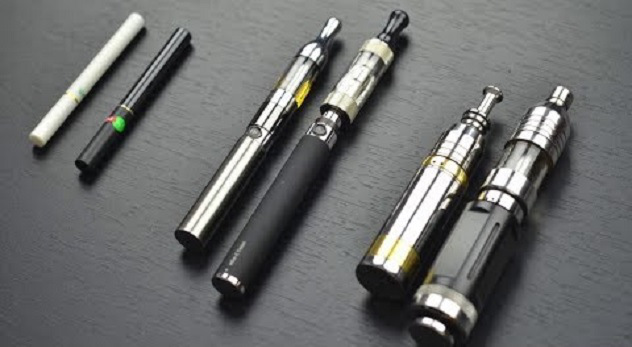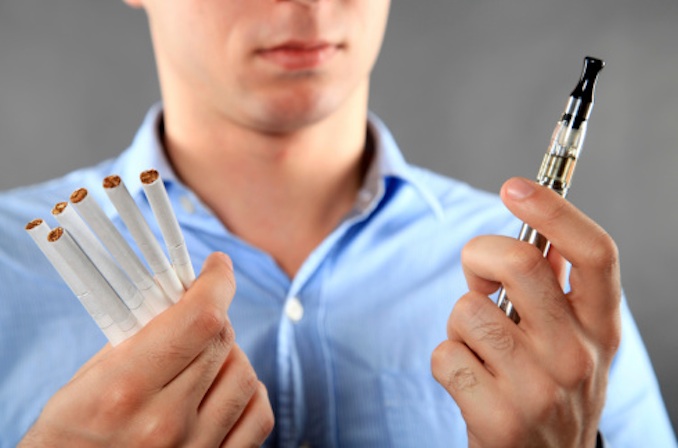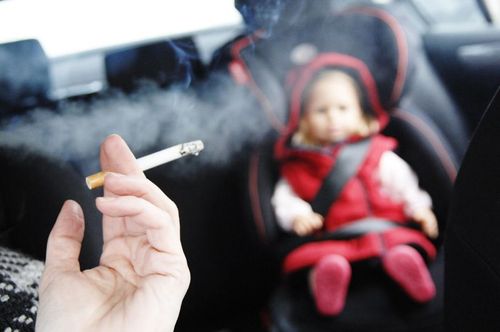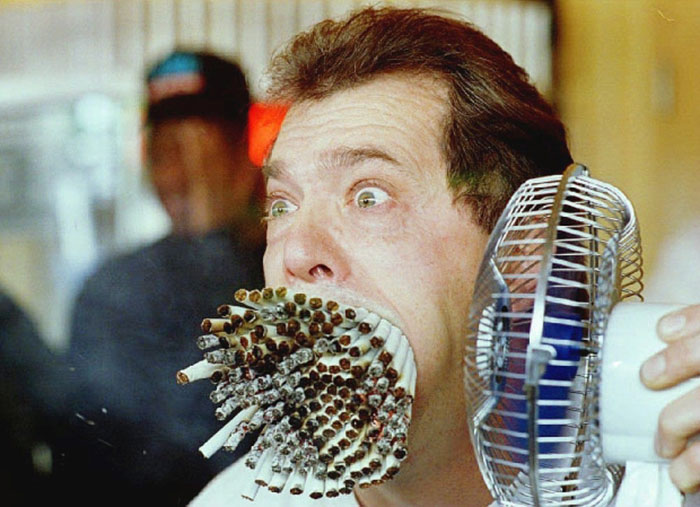9 Things You Should Know About Vaping Before You Think It's Safer Than Cigarettes
The vaping trend has been increasingly booming in not only Malaysia, but globally as well. Here's an exhaustive list of what we know so far.
1. There are two completely different products that are referred to as 'e-cigarettes', also known as vapourisers
When most people think of an electronic cigarette also known as vapourisers, they think of the mass market product pictured above on the far left. They look like regular cigarettes and they come with pre-filled, replaceable cartridges. They have very limited flavor selections.
However, the common vapourisers that people use now are Vape Pens (middle) and Vape Mods (right). Vape Pens contain electronics allowing the user to regulate the power level, produce a moderate amount of vapor. Mods are for use with user-rebuildable atomizers, which produce tons of vapor and can be quite expensive.
Users are typically introduced to vaping with the products on the left, move to the middle for a more satisfying vape as the first are very high nicotine and low vapor, and end up on the right when they really start wanting more flavor and less nicotine. This is important because lawmakers and the media absolutely do not differentiate between the two products, yet there is a world of difference.
2. Vapourisers are believed to be safe as manufacturers state that the e-liquid ingredients are known substances used in asthma inhalers, food-grade flavoring, and pharmaceutical-grade nicotine
E-liquid begins with the main base, vegetable glycerin. Manufacturers use it as it produces a lot of vapour.
Another ingredient propylene glycol (PG) which is usually cited by alarmists as being a "main ingredient in antifreeze." This is incorrect, as they're confusing it with diethylene glycol, which has actually been found in mass market e-cig products. Propylene glycol is a main ingredient in albuterol, or asthma inhalers, and is perfectly safe to inhale when vaporized.
Flavorings are food-grade, can be natural or artificial, and are limited only by the imagination of the juice maker. A note about these ingredients—the "we don't know what's in these things" arguments dissolve in the face of numerous studies, showing that not only do we understand completely what's in these things, but we also have a solid understanding of their (negligible) toxicity when vaporized.
The final ingredient is pharmaceutical-grade nicotine, and all juice manufacturers make their product available in varying nicotine strengths. They range from ridiculous (up to 36 milligrams per milliliter—basically a Lucky Strike with the filter ripped off) all the way down to nothing at all. That's right, zero.
 gizmodo.com
gizmodo.com
3. However, there isn't much information in regards to the ingredients' effects from being huffed. Some known effects from the inhalation of propylene glycol may lead to issues with the central nervous system, spleen and respiratory issues among others.
"We have little information about what happens to propylene glycol in the air," the federal Agency for Toxic Substances and Disease Registry website declares. We do know that habitual inhalation of aerosolized PG in industrial settings can lead to issues with the central nervous system, personality and behavior changes, and reduced spleen function. In fact, the Dow Chemical Company states that "inhalation exposure to [propylene glycol] mists should be avoided," and the American Chemistry Council has repeatedly issued warnings about inhaling theater fog as it may contribute to eye and respiratory infections.
Even better, when heated above a certain temperature, PG will convert to propylene oxide - a class 2B carcinogen as rated by the International Agency for Research.
4. A firm stance people have used to defend vaporisers is that it contains very little to no nicotine. According to a report from Bend Bulletin, this helps to decrease users' nicotine intake in their quest to reduce or quit smoking according to Bend Bulletin
In our business, e-liquid in very low to zero nicotine strength (6 mg per ml and below) outsells medium-to-high strengths (12 mg and above) by better than a two-to-one margin.
Most users start off at a high nicotine level when they are still getting off cigarettes. When a beginner graduates to a device that produces more vapor, they don't need as high a concentration of nicotine to be satisfied.
Then, they may want to further "step down" (decrease the nicotine strength) once they find that high nicotine actually screws with the flavor of an e-liquid.
Simply put, the less nicotine you use, the better your liquid will taste and, despite what media pundits seem to think, it turns out that even adults like things that taste good.
 gizmodo.com
gizmodo.com
5. But nicotine-free is not 100% safe, as e-cigarette solutions have been found to contain harmful substances that may harm a person's health, particularly their lungs
Interestingly, nicotine-free e-cig solutions were also found to include lung-harming substances, such as acrolein. This substance, which is present in both e-cig solution and vapor, has been shown to damage the lungs by attacking the molecules that hold endothelial cells together.
This research reports that components found in commercially available e-cigarette solutions and vapors generated by heating them may cause lung inflammation,” said lead researcher Irina Petrache, PhD. “The effects described characterize short-term effects of e-cig exposures.
6. On the plus side, it has been statistically proven that the increase in the use of vaporisers have resulted in fewer teenagers opting for cigarettes in recent days
E-cigarette use among middle school students tripled from 1.1 to 3.9% between 2013 and 2014. The numbers are even more dire for high school students — theirs spiked from 4.5 to to 13.5% percent over the same period of time. Between 2011 and 2014, statistically significant increases were observed among these students for current use of both e-cigarettes and hookahs, while decreases were observed for current use of more traditional products, such as cigarettes and cigars, resulting in no change in overall tobacco use.
At the same time, though, the number of high school smokers had dropped from 16 percent in 2011 to 9 percent in 2014.
7. With this increase, however, critics have also contended that vaping is trading one form of addiction for another. The safer-than-cigarettes claims are convincing teens to adopt a nicotine habit they might not have otherwise.
Sue Matson, substance abuse prevention coordinator at the Johnson County Mental Health Department said, “I’m concerned about the possibility of renormalizing behavior that we have spent a long time getting away from.”
A recent study by the Centers for Disease Control and Prevention found that the use of e-cigarettes by teenagers had risen sharply, with 13 percent of high schoolers reportedly using them in 2014.
“They (teenagers) believe it’s a safe alternative because that’s what they are being told,” said Kevin Kufeldt, who runs a regional drug treatment center that serves adolescents from across Kansas. Many adults, she said, believe they are doing their teens a favor by allowing them to vape, rather than smoke, when the better alternative is to do neither.
The number of young people in the US who have tried e-cigarettes tripled from 2011 to 2013, the US Centers for Disease Control and Prevention said, adding that more than a quarter of a million young people who had never smoked a cigarette used e-cigarettes last year.
8. Nonetheless, many studies have found that the vapour is far less harmful than cigarette smoke, suggesting that it does not affect surrounding people with secondhand smoke
A 2012 Greek study entitled Acute effects of using an electronic nicotine-delivery device on myocardial function: comparison with regular cigarettes: "Absence of combustion and different chemical composition, leading to less toxic chemicals created and absorbed . . . electronic cigarettes may be a safer alternative to tobacco cigarettes."
escardio.orgA 2012 research paper entitled Levels of selected carcinogens and toxicants in vapor from electronic cigarettes: "We found that the e-cigarette vapors contained some toxic substances. The levels of the toxicants were 9–450 times lower than in cigarette smoke and were, in many cases, comparable with trace amounts found in the reference product.
Our findings are consistent with the idea that substituting tobacco cigarettes with e-cigarettes may substantially reduce exposure to selected tobacco-specific toxicants. E-cigarettes as a harm reduction strategy among smokers unwilling to quit, warrants further study.
A 2012 study entitled Comparison of the effects of e-cigarette vapor and cigarette smoke on indoor air quality: "For all byproducts measured, electronic cigarettes produce very small exposures relative to tobacco cigarettes. The study indicates no apparent risk to human health from e-cigarette emissions based on the compounds analyzed."
9. Another strong point is that research has shown that vaping has helped many smokers to reduce their cigarette consumption without significant withdrawal symptoms and has even led to many smokers quitting the habit
"In a large, international survey (emphasis mine) of current, former, or never users of e-cigarettes, 72 percent of users reported that e-cigarettes helped them to deal with cravings and withdrawal symptoms, 92 percent reported reductions in their smoking when using e-cigarettes, and only 10 percent reported that they experienced the urge to smoke tobacco cigarettes when using the e-cigarette.
Moreover, of more than 2000 former smokers in this survey, 96 percent reported that the e-cigarette helped them to stop smoking."
"In smokers not intending to quit, the use of e-cigarettes, with or without nicotine, decreased cigarette consumption and elicited enduring tobacco abstinence without causing significant side effects."








